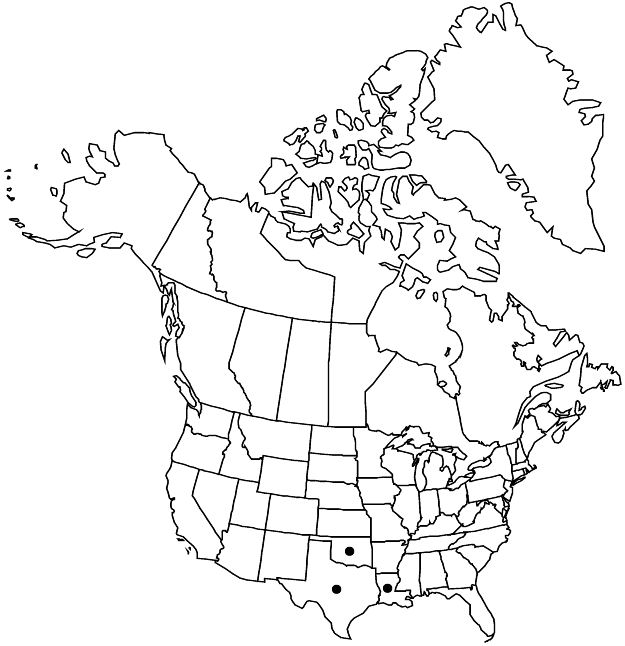Difference between revisions of "Euphorbia tetrapora"
in W. H. Emory, Rep. U.S. Mex. Bound. 2(1): 191. 1859.
FNA>Volume Importer |
imported>Volume Importer |
||
| (3 intermediate revisions by 2 users not shown) | |||
| Line 1: | Line 1: | ||
{{Treatment/ID | {{Treatment/ID | ||
|accepted_name=Euphorbia tetrapora | |accepted_name=Euphorbia tetrapora | ||
| − | |accepted_authority=Engelmann | + | |accepted_authority=Engelmann |
|publications={{Treatment/Publication | |publications={{Treatment/Publication | ||
| − | |title=Rep. U.S. Mex. Bound. | + | |title=in W. H. Emory, Rep. U.S. Mex. Bound. |
|place=2(1): 191. 1859 | |place=2(1): 191. 1859 | ||
|year=1859 | |year=1859 | ||
| Line 16: | Line 16: | ||
|name=Tithymalus tetraporus | |name=Tithymalus tetraporus | ||
|authority=(Engelmann) Small | |authority=(Engelmann) Small | ||
| + | |rank=species | ||
}} | }} | ||
|hierarchy=Euphorbiaceae;Euphorbia;Euphorbia subg. Esula;Euphorbia tetrapora | |hierarchy=Euphorbiaceae;Euphorbia;Euphorbia subg. Esula;Euphorbia tetrapora | ||
| Line 40: | Line 41: | ||
-->{{#Taxon: | -->{{#Taxon: | ||
name=Euphorbia tetrapora | name=Euphorbia tetrapora | ||
| − | + | |authority=Engelmann | |
| − | |authority=Engelmann | ||
|rank=species | |rank=species | ||
|parent rank=subgenus | |parent rank=subgenus | ||
| Line 52: | Line 52: | ||
|distribution=La.;Okla.;Tex. | |distribution=La.;Okla.;Tex. | ||
|reference=None | |reference=None | ||
| − | |publication title=Rep. U.S. Mex. Bound. | + | |publication title=in W. H. Emory, Rep. U.S. Mex. Bound. |
|publication year=1859 | |publication year=1859 | ||
|special status=Endemic | |special status=Endemic | ||
| − | |source xml=https:// | + | |source xml=https://bitbucket.org/aafc-mbb/fna-data-curation/src/2e0870ddd59836b60bcf96646a41e87ea5a5943a/coarse_grained_fna_xml/V12/V12_390.xml |
|genus=Euphorbia | |genus=Euphorbia | ||
|subgenus=Euphorbia subg. Esula | |subgenus=Euphorbia subg. Esula | ||
Latest revision as of 19:15, 5 November 2020
Herbs, annual, with taproot. Stems erect, unbranched, 7–20 cm, glabrous. Leaves: petiole 1–2 mm, reduced distally; blade spatulate-cuneate, 8–10 × 4–5 mm (greatly reduced in size proximally), base cuneate, margins entire, apex rounded to emarginate or obcordate, surfaces glabrous; venation pinnate. Cyathial arrangement: terminal pleiochasial branches 3, each 1–3(–4) times 2-branched; pleiochasial bracts obovate, similar in size to distal leaves; dichasial bracts distinct or basally subconnate, not imbricate, triangular-ovate, base truncate or cordate, margins entire, apex mucronate; axillary cymose branches 1–4. Cyathia: peduncle 0.2–0.6 mm. Involucre campanulate, 0.8–1.1 × 0.7–1 mm, glabrous; glands 4, elliptic to trapezoidal, 0.3–0.6 × 0.6–1.2 mm; horns divergent, 0.5–1 mm. Staminate flowers 10–15. Pistillate flowers: ovary smooth, glabrous; styles 0.6–1 mm, 2-fid. Capsules depressed-globose, 1.8–2.2 × 2.2–2.9 mm, slightly lobed; cocci rounded to slightly flattened, smooth, glabrous; columella 1.5–1.8 mm. Seeds reddish brown to brown, often glaucous, oblong, 1.3–1.4 × 0.8–0.9 mm, abaxial faces with 15–20 shallow pits or almost smooth, adaxial faces with 4–6 large shallow pits or irregular oblong grooves; caruncle conic, hat-shaped, 0.3–0.4 × 0.4–0.6 mm.
Phenology: Flowering and fruiting spring.
Habitat: Sandy soils, dry open woods.
Elevation: 0–300 m.
Distribution

La., Okla., Tex.
Discussion
Euphorbia tetrapora is endemic to a portion of the western Gulf coastal plain. D. S. Correll and M. C. Johnston (1970) included Alabama and Georgia in the distribution of this species as well, probably due to Engelmann’s citation of a Georgia specimen from the herbarium of Samuel Boykin. Whether the Boykin specimen came from Georgia, where Boykin was based, is unclear. Because no records to support its occurrence in the eastern Gulf coastal plain (Alabama or Georgia) have been found, those states are here excluded from the distribution of E. tetrapora.
Selected References
None.